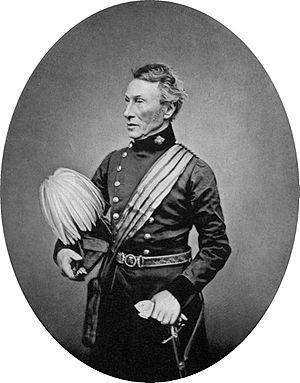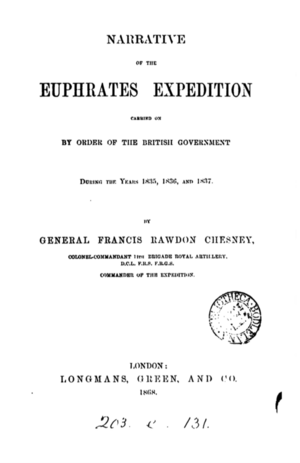Francis Rawdon Chesney facts for kids
Quick facts for kids
Francis Rawdon Chesney
|
|
|---|---|

Chesney in 1863
|
|
| Born | 16 March 1789 Annalong |
| Died | 30 January 1872 (aged 82) |
| Allegiance | British |
| Service/ |
Royal Artillery |
| Years of service | 1805-1847 |
| Rank | General |
| Commands held | 7th Company, 4th Battalion Royal Artillery |
| Awards | Royal Geographical Society's Founder's Medal (1838) |
| Alma mater | Royal Military Academy, Woolwich |
Francis Rawdon Chesney (born March 16, 1789 – died January 30, 1872) was a British general and explorer. He is best known for his important work on the Suez Canal idea and his expeditions to explore the Euphrates River. His efforts helped open up new routes for trade and travel.
Contents
Early Life and Military Career
Francis Rawdon Chesney was born in Annalong, Ireland, on March 16, 1789. His father, Captain Alexander Chesney, was an Irishman of Scottish background. He had served in the American Revolutionary War before becoming a coast officer in Ireland.
Young Francis was given a special opportunity to study at the Royal Military Academy, Woolwich. He joined the Royal Artillery in 1805. Chesney rose through the ranks, eventually becoming a general in 1868. However, he is most remembered for his explorations rather than his military battles.
Exploring New Routes
Chesney's adventures began in 1829 when he was sent to Constantinople (modern-day Istanbul) for military duties. While there, he traveled through Egypt and Syria. In 1830, he wrote a report about how a canal could be built across the Isthmus of Suez. This idea later became the basis for the famous Suez Canal. In fact, when the Suez Canal opened in 1869, its builder, Ferdinand de Lesseps, called Chesney the "father" of the canal!
Before the Suez Canal was built, Chesney wanted to find another way to reach India. The usual route was a very long journey around the southern tip of Africa, called the Cape of Good Hope. He believed the Euphrates River could be used for steamboats.
The Euphrates Expedition's Goals
Chesney worked hard to convince the British government to try out the Euphrates route. In 1835, the government agreed to send two iron steamboats, the Euphrates and the Tigris, to explore the river. The main goals of this expedition were:
- To create a new, faster trade route between Britain and India.
- To prevent Russia from expanding its influence in the Near East, which was seen as a threat to Britain's control of India.
Captain Francis Rawdon Chesney led the expedition. He carefully chose about fifty people to join him. The British Parliament provided £20,000 for the project.
The Euphrates Expedition
The expedition arrived in Malta on March 12, 1835. From there, they transported all their materials to the Bay of Antioch. It took over a year to build the two iron steamboats.
On March 16, 1836, Chesney's 47th birthday, the Euphrates began its first trial voyage. Good relationships with the local Arab people were very important for the expedition's success. These relationships also helped maintain a steady service along the river, which might make Russia think twice before trying to invade Iraq.
Challenges on the River
The expedition made stops along the way to get wood for fuel and to do historical research. On May 21, 1836, a terrible hurricane suddenly hit the boats. William Francis Ainsworth, the expedition's surgeon and geologist, described a "tremendous blast of wind." After just twelve minutes, the storm ended, but the Tigris was gone. It had sunk, and many lives were lost.
Chesney had orders to end the expedition by the end of July. However, he believed the loss of the Tigris changed things. He thought the government wouldn't want to cancel such an important British project after one accident. So, the team decided to continue down the river on the Euphrates. They sent the survivors of the Tigris wreck back home to save money.
The Euphrates then stopped at the city of Ana for repairs and refueling. More challenges arose during their journey. Once, Chesney accidentally left Ainsworth on the riverbank! Ainsworth had to walk over fifty miles for two days to catch up. Another time, the ship was surrounded by people from the Khezail tribe.
Expedition's End
By June 18, 1836, Chesney noted that they had successfully explored about 1200 miles of the Euphrates River. They also examined the Karun River and Bah-a-Mishir in September 1836. The final part of the mission was to travel up the Tigris River to Baghdad.
However, the river became very narrow and winding. On October 24, they could not go any further. With no new orders from India or England, Chesney had to decide what to do. He chose to go to Bombay himself on December 1, 1836. He left James Bucknall Bucknall Estcourt in charge, with instructions to continue exploring the Karun and Tigris rivers.
The expedition officially ended on January 25, 1837, in Baghdad. Chesney returned to England later that year. He believed the expedition proved that the Euphrates route to India was possible.
Life After the Expedition
When Chesney returned to England, he received the Royal Geographical Society's Founder's Medal. He was also given money to write the official story of the expedition. This book, called the Official Narrative of the Euphrates Expedition, was published in 1850.
Chesney continued to push for a communication line with India through Turkish Arabia. He believed his expedition showed how fast and useful this route could be for trade. In 1843, he was sent to command the artillery in Hong Kong.
In 1847, Chesney retired from military service and returned to Ireland. However, he didn't stop working on his big ideas. In 1856 and again in 1862, he went back to the East. He helped with more surveys and talks for a railway project in the Euphrates valley. Even though a House of Commons committee gave a good report in 1871, the government never built the railway.
In 1868, Chesney published another book about his Euphrates expedition. He passed away on January 30, 1872.
Family
Chesney's wife, Louisa, lived for 30 years after him. She died in 1902 at the age of 86.
See also
- Johann Wilhelm Helfer; participated in and wrote about the Euphrates expedition
- William Francis Ainsworth; participated in and wrote about the Euphrates expedition
- Henry Blosse Lynch; participated in the Euphrates expedition



